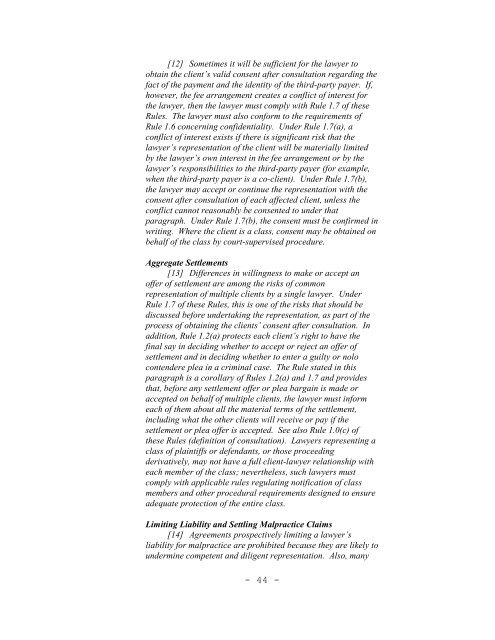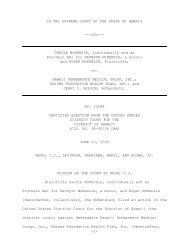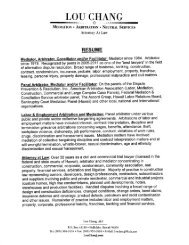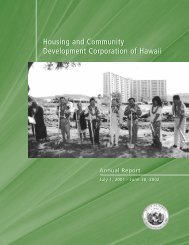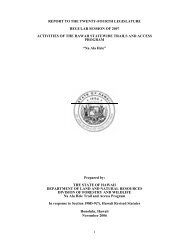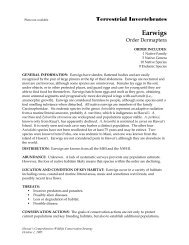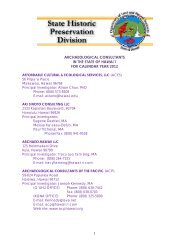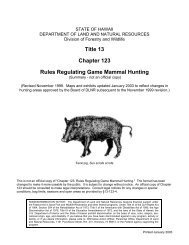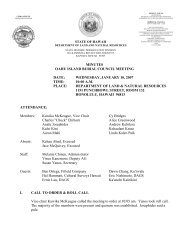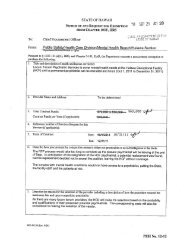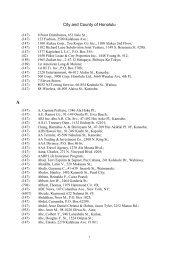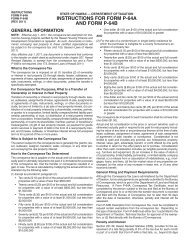amendments to the Hawaii Rules of Professional Conduct
amendments to the Hawaii Rules of Professional Conduct
amendments to the Hawaii Rules of Professional Conduct
You also want an ePaper? Increase the reach of your titles
YUMPU automatically turns print PDFs into web optimized ePapers that Google loves.
[12] Sometimes it will be sufficient for <strong>the</strong> lawyer <strong>to</strong><br />
obtain <strong>the</strong> client’s valid consent after consultation regarding <strong>the</strong><br />
fact <strong>of</strong> <strong>the</strong> payment and <strong>the</strong> identity <strong>of</strong> <strong>the</strong> third-party payer. If,<br />
however, <strong>the</strong> fee arrangement creates a conflict <strong>of</strong> interest for<br />
<strong>the</strong> lawyer, <strong>the</strong>n <strong>the</strong> lawyer must comply with Rule 1.7 <strong>of</strong> <strong>the</strong>se<br />
<strong>Rules</strong>. The lawyer must also conform <strong>to</strong> <strong>the</strong> requirements <strong>of</strong><br />
Rule 1.6 concerning confidentiality. Under Rule 1.7(a), a<br />
conflict <strong>of</strong> interest exists if <strong>the</strong>re is significant risk that <strong>the</strong><br />
lawyer’s representation <strong>of</strong> <strong>the</strong> client will be materially limited<br />
by <strong>the</strong> lawyer’s own interest in <strong>the</strong> fee arrangement or by <strong>the</strong><br />
lawyer’s responsibilities <strong>to</strong> <strong>the</strong> third-party payer (for example,<br />
when <strong>the</strong> third-party payer is a co-client). Under Rule 1.7(b),<br />
<strong>the</strong> lawyer may accept or continue <strong>the</strong> representation with <strong>the</strong><br />
consent after consultation <strong>of</strong> each affected client, unless <strong>the</strong><br />
conflict cannot reasonably be consented <strong>to</strong> under that<br />
paragraph. Under Rule 1.7(b), <strong>the</strong> consent must be confirmed in<br />
writing. Where <strong>the</strong> client is a class, consent may be obtained on<br />
behalf <strong>of</strong> <strong>the</strong> class by court-supervised procedure.<br />
Aggregate Settlements<br />
[13] Differences in willingness <strong>to</strong> make or accept an<br />
<strong>of</strong>fer <strong>of</strong> settlement are among <strong>the</strong> risks <strong>of</strong> common<br />
representation <strong>of</strong> multiple clients by a single lawyer. Under<br />
Rule 1.7 <strong>of</strong> <strong>the</strong>se <strong>Rules</strong>, this is one <strong>of</strong> <strong>the</strong> risks that should be<br />
discussed before undertaking <strong>the</strong> representation, as part <strong>of</strong> <strong>the</strong><br />
process <strong>of</strong> obtaining <strong>the</strong> clients’ consent after consultation. In<br />
addition, Rule 1.2(a) protects each client’s right <strong>to</strong> have <strong>the</strong><br />
final say in deciding whe<strong>the</strong>r <strong>to</strong> accept or reject an <strong>of</strong>fer <strong>of</strong><br />
settlement and in deciding whe<strong>the</strong>r <strong>to</strong> enter a guilty or nolo<br />
contendere plea in a criminal case. The Rule stated in this<br />
paragraph is a corollary <strong>of</strong> <strong>Rules</strong> 1.2(a) and 1.7 and provides<br />
that, before any settlement <strong>of</strong>fer or plea bargain is made or<br />
accepted on behalf <strong>of</strong> multiple clients, <strong>the</strong> lawyer must inform<br />
each <strong>of</strong> <strong>the</strong>m about all <strong>the</strong> material terms <strong>of</strong> <strong>the</strong> settlement,<br />
including what <strong>the</strong> o<strong>the</strong>r clients will receive or pay if <strong>the</strong><br />
settlement or plea <strong>of</strong>fer is accepted. See also Rule 1.0(c) <strong>of</strong><br />
<strong>the</strong>se <strong>Rules</strong> (definition <strong>of</strong> consultation). Lawyers representing a<br />
class <strong>of</strong> plaintiffs or defendants, or those proceeding<br />
derivatively, may not have a full client-lawyer relationship with<br />
each member <strong>of</strong> <strong>the</strong> class; never<strong>the</strong>less, such lawyers must<br />
comply with applicable rules regulating notification <strong>of</strong> class<br />
members and o<strong>the</strong>r procedural requirements designed <strong>to</strong> ensure<br />
adequate protection <strong>of</strong> <strong>the</strong> entire class.<br />
Limiting Liability and Settling Malpractice Claims<br />
[14] Agreements prospectively limiting a lawyer’s<br />
liability for malpractice are prohibited because <strong>the</strong>y are likely <strong>to</strong><br />
undermine competent and diligent representation. Also, many<br />
- 44


